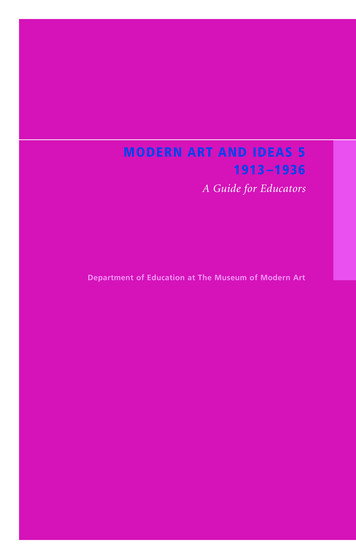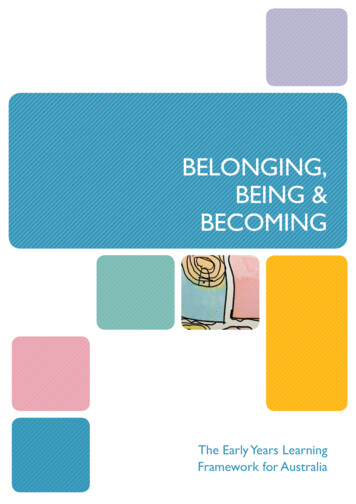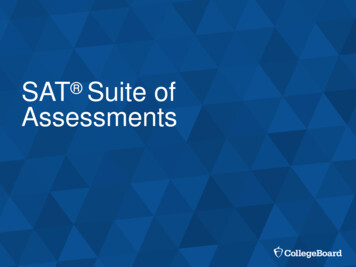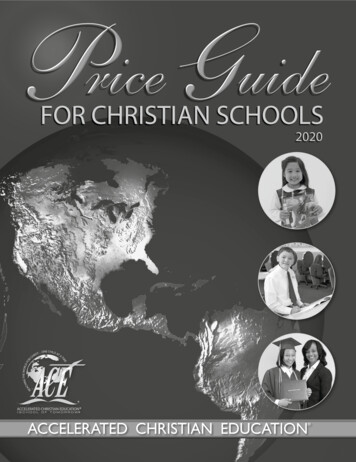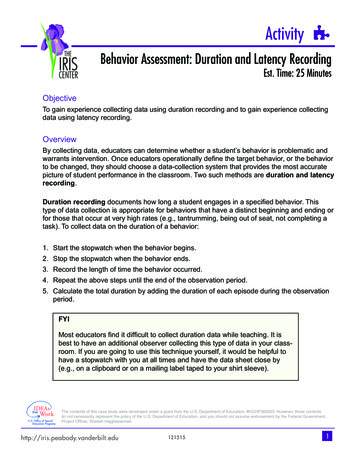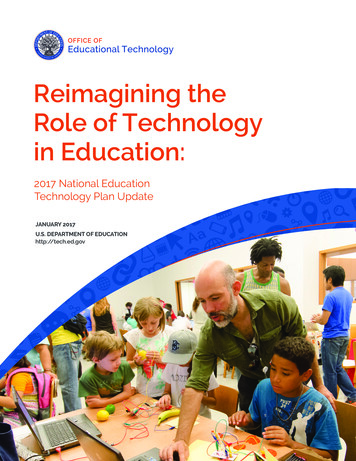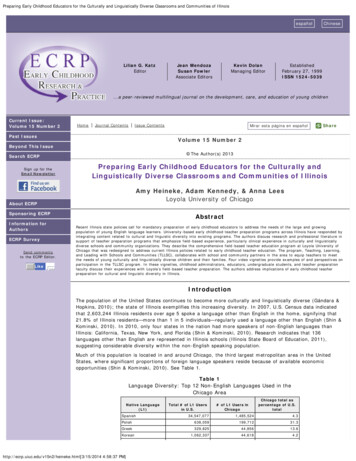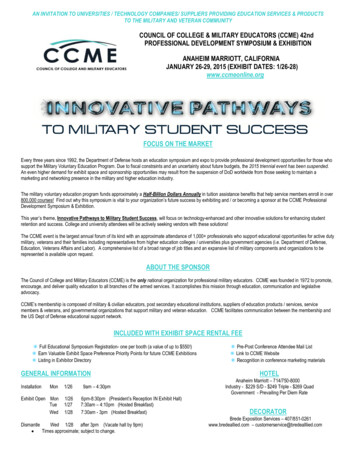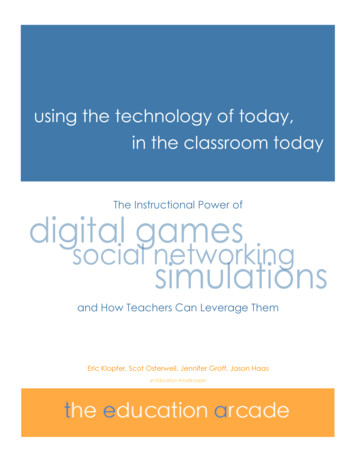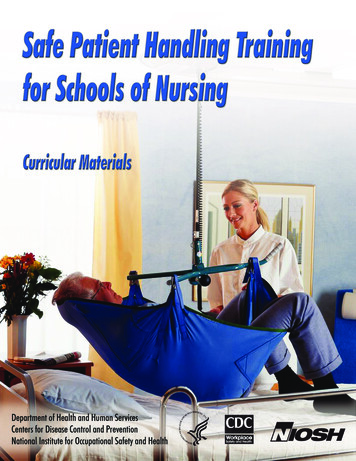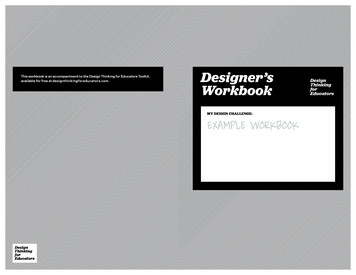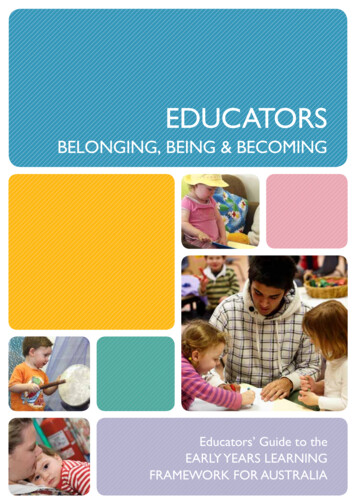
Transcription
EDUCATORSBELONGING, BEING & BECOMINGEducators’ Guide to theEARLY YEARS LEARNINGFRAMEWORK FOR AUSTRALIA
Produced by the Australian Government Department of Education, Employment and WorkplaceRelations for the Council of Australian Governments. Commonwealth of Australia 2010ISBN 978-0-642-77918-2 [Print]ISBN 978-0-642-77919-9 [PDF]ISBN 978-0-642-77920-5 [RTF]This work is copyright. Apart from any use as permitted under the Copyright Act 1968, no part may bereproduced by any process without prior written permission from the Commonwealth. Requests and inquiriesconcerning reproduction and rights should be addressed to the Commonwealth Copyright Administration,Attorney-General’s Department, Robert Garran Offices, National Circuit, Barton ACT 2600 or posted athttp://www.ag.gov.au/cca
Contents1. Introduction:using the Guide with the Framework32.7Reflective practice for improvement3. Curriculum decision making:the key to implementing the Framework104. Linking beliefs and theoretical perspectives with practice:exploring the relationship between the Framework’sPrinciples, Practice and learning Outcomes145. Partnerships: working with families and community176.21Cultural competence7. The journey for educators:growing competence in working with AustralianAboriginal and Torres Strait Islander cultures248. Learning through play309.Continuity of learning and transitions3410.Assessment for learning3711. Learning outcomes4212. Glossary of terms4713.References and resources4914.The early years learning framework in action58EDUCATORS Belonging, Being & Becoming1
Abbreviations used in this document: The Framework: Belonging, Being & Becoming: The Early Years Learning Framework for Australia The Guide: Educators Belonging, Being & Becoming: Educators’ Guide to the Early Years LearningFramework for Australia The Reflect Respect Relate resource or RRR: REFLECT RESPECT RELATEAssessing for learning and development in the early years using observation scales (2008, DECS)The terms used in the Guide are consistent with the Framework. For explanations see the definition boxesand glossary in the Framework.2EDUCATORS Belonging, Being & Becoming
1. Introduction:using the Guide with the FrameworkBelonging, Being & Becoming: the Early Years Learning Framework for Australia and Educators Belonging,Being & Becoming: Educators’ Guide to the Early Years Learning Framework for Australia are intended tosupport curriculum decision making to extend and enrich children’s learning from birth to five years andthrough the transition to school (Framework, p.5).A new vision for AustraliaThe Early Years Learning Framework is animportant and timely resource for early childhood.It embraces a vision for a new Australia:The Framework provides an opportunity foreducators across Australia to work towards: a clear focus on children’s learning and wellbeing a shared language for curriculum in the earlychildhood field a future that embraces all Australians a future based on mutual respect, mutual resolveand mutual responsibility a base for planning, promoting andassessing learning a future where all Australians, whatever theirorigins, are truly equal partners, with equalopportunities and with an equal stake in shapingthe next chapter in the history of Australia. improved quality in early childhood settings cultural security for Aboriginal and Torres StraitIslander children and their families including families and communities inchildren’s learning.To this end, the Framework is built around a numberof key concepts and principles which requireeducators to use particular understandings andpractices effectively to achieve the desired outcomes.This Guide will help educators do this in theirlocal settings.A major feature that distinguishes Australia from allother countries in the world is the ancestralrelatedness of Indigenous people. This relatednessforms the world’s oldest living culture. Acknowledgmentof Indigenous ancestral relatedness, its values, andhow these are realised is distinctly Australian.The Council of Australian Governments is committedto closing the gap in educational achievementsbetween Indigenous and non-Indigenous Australianswithin a decade (Framework, p.6).When starting to use the Framework rememberthat it is just that – a framework. It is not a syllabus,not a program, not a curriculum, not a model, notan assessment tool, not a detailed description ofeverything children will learn. It is a framework ofprinciples, practices and outcomes with which tobuild your curriculum.It is based on the best available evidence and what issocially and culturally important. As such, some ideaswill be consistent with some of your practices andknowledge, and some will be challenging, new andvery particular to Australia. This provides excellentopportunities for all educators to build on theircurrent knowledge and experience, so that theircurriculum decision making (both intuitive andreflective judgements) are consistent with currentthinking and expectations.EDUCATORS Belonging, Being & Becoming3
Both the Framework and the Guide are for earlychildhood educators in all Australian early childhoodsettings working in partnership with families andchildren and may complement, supplement or replacesettings’ current frameworks. The Guide providessupport for individuals and collegial teams to use theFramework.Respect for diversity underpins the Framework andthe Guide. Both documents recognise the diversityof educators’:A new vision for educators personal history, experiences and values professional pathways and qualifications beliefs about childhood, children, learning andcurriculum journey and drive for cultural competenceThere are several big bits to education. One is thecurriculum (what we want people to learn); then there’steaching (how we help them to learn); and assessment(how we make judgements about how they are gettingon).We focus on curriculum (usually maths, language,science), then assessment (usually standardised tests).The bit we leave out is the quality of teaching Most reform systems are looking backwards; they’relooking back to the old system that was the result of theindustrial revolution.We no longer want a better steamengine.We need to rethink.To get back to what drivespeople to learn and achieve. education is about kidsand energising them (Sir Ken Robinson, 2009). use of theoretical perspectives.Educators Belonging, Being & Becoming, the Educators’Guide to support the use of the Framework, takesan approach that values educators engaging inprofessional growth leading to thoughtful judgementand decision making for all children’s learning.Evidence shows that reflective practice can helpeducators to think more deeply about their work andmotivate them to explore new ideas and approaches(see, for example, Anning & Edwards, 2006).The Framework and the Guide aim to embedreflective practice and inquiry into educators’everyday practices. For educators:The following concepts of the Framework areexplored in the Guide: 4Belonging relates to connections and relationshipswith other educators and professionals fromother disciplines, participation in professionalorganisations and networks, and communityinvolvement. Being relates to the individuality of each earlychildhood educator and to the distinctiveness ofeach team of educators. Individuals and groupsbring a unique collection of beliefs, values,interests, knowledge, experience and perspectivesto planning, practice and relationships. Becoming relates to the importance of learningand reflecting in order to increase professionalknowledge and improve skills and practices.EDUCATORS Belonging, Being & BecomingUsing the GuideThe Guide is designed to be used in interactiveways to promote in-depth conversations and thinkingover a sustained period about the concepts whichbuild the Framework. It is not intended to be read inone sitting. Rather, individuals and teams of educatorsmay find it helpful to ‘dip’ into the Guide at differentpoints, to focus on one section at a time, and tobegin with the section of most interest to them.Most readers will find it helpful to read theFramework before turning to the Guide. belonging, being and becoming and their links tolearning principles, practices and pedagogy, including playand partnerships with families, to support learning reflective practice curriculum decision making to foster children’slearning in areas identified by five broadLearning Outcomes facilitating children’s transitions in the early years developing cultural competence Australian Aboriginal and Torres Strait Islandercultural competence using theoretical perspectives.
Both the Framework and the Guide are designed toengage educators in critical thinking, reflection andinquiry. As such they are not prescriptive or ‘recipe’books – but rather are intended to provoke, inspireand challenge. They recognise that there is not one‘right way’ to provide for children’s learning. Theyprovide a range of ways to think about children’slearning. If we think there is just one right way and ifwe have no doubt about the quality of our provision,we leave little room for reflection, for questioning orfor change.The sections that follow this Introduction all havea similar format. Each major section starts with aquote from the Framework and then is divided intothe following segments which help you to exploreparticular concepts in the Guide:Talk and reflect about—includes reflectivequestions and suggestions for going deeperTry out—possible entry pointsHear about—stories and models of practiceFind more about—links to other resources.Photos are included to illustrate the links betweenthe Principles, Practice and Learning Outcomes.Each section has a reference to the Reflect RespectRelate resource which provides a guide for educatorsto critically reflect on pedagogy and relationshipsand the connection with children’s wellbeing andinvolvement in learning.Think about—explanatory information aboutthe sectionElements of the Early Years Learning ACTICEHolistic approachesLearningenvironmentsPlay-based curriculum and intentionalteachingResponsiveness tochildrenCultural competencePhysicaland social learning environmentsLearning throughplayof learning and transitionsContinuityof learningContinuityand transitionsIntentional teaching Assessment for learningAssessment for learningBEINGINGMOCsihoinpacntsES rienltaetrioieselilPLCI rsoitciva lfiaemsIN decpipo faimthi uityePR danr pitsh w siteyqcticlipans shwi aenrd yyntfsuh ieprs ndsiv suiitt prateioc rsthn taftoior tdoiveqr cteiveicelsap npeatcee, r nuPianre eexspe cutnfiotyr prreafcletcuurre iavnedSSeec Ge HighR oesmpmtCR renfliencgleRainggoOnEAildrRNen ChildareC reINncGhhaCoilOUCh hildr dnnreenct ve aesildrpetnen hav adrtwicit rong TCOChieMEildr are c a st phaatend senseen onf ron inccoofSiare den g se onmidtibu entieffe t an nse rmttnyeitctiv d ioe c nvo f wel iteos thom lved lbe eirinwomurldnic learn gato ersrsLONGINGEBEDUCATORS Belonging, Being & Becoming5BE
In addition, there is a further resource—The EarlyYears Learning Framework in Action. This resourcecontains educators’ stories and models of their plansfor and outcomes of children’s learning, withquestions to provoke thinking and to generatediscussion in relation to the Principles, Practices andLearning Outcomes of the Framework. The storiesdemonstrate the holistic nature of children’s learningand the way educators have integrated the Principles,Practices and Learning Outcomes of the Frameworkinto their curriculum.The Guide can be used in many ways including: using one section at a time in staff meetings,network meetings and collaborative professionalconversations using the Guide as a working document andadding personal journal entries, stories, articles,photos, feedback specific to the various sections.Each section of the Guide is interdependent with theothers. That is, no one section stands alone. When weare thinking about our curriculum decision makingwe are also thinking about working in partnershipswith families, about play, about monitoring children’slearning, and so on. When we are thinking aboutcultural competence we are also thinking about ourtheories and beliefs, our families and communities,outcomes for children and so on.Who is responsible for implementingthe Framework?The Framework outlines best practice and reflectscontemporary early childhood research and theory.It provides guidance and parameters for qualitypractice and it is intended that educators’ practice isinformed by it. The Framework encourages everyonewho works with young children to see themselvesas pedagogical leaders. If you work with youngchildren you are responsible for using the Framework.The term pedagogy refers to the holistic natureof early childhood educators’ professional practice.Pedagogical leaders take an active role in promotingearly childhood educators’ practice, especiallythose aspects that involve building and nurturingrelationships, curriculum decision making, teachingand learning.6EDUCATORS Belonging, Being & BecomingWhen educators establish respectful and caringrelationships with children and families, they areable to work together to make curriculum andlearning experiences relevant to children in theirlocal context. These experiences gradually expandchildren’s knowledge and understanding of the world.Educators’ professional judgements are central totheir active role in facilitating children’s learning:As [educators], all we have at a given moment in agiven situation is our very best judgement.Throughoutour professional lives we study and reflect in order torefine that judgement; we exchange with colleagues,consider others’ solutions to the problems we face, wecome together at meetings, we examine the availableevidence—all in order to improve our judgement. In thelast analysis, our very best judgement is all there is(Katz, 2008).Both the Framework and the Guide aim to improveprofessional judgement and practice, especiallycurriculum decision making, by encouraging a cycleof questioning, planning, acting and reflecting that willbuild professional knowledge and confidence. Thisknowledge and confidence will support educatorsto make informed judgements so that all childrenexperience learning that is engaging and builds successfor life (Framework, p.7).
2. Reflective practicefor improvementWhat the Framework saysA lively culture of professional inquiry is established when early childhood educators and those with whom theywork are all involved in an ongoing cycle of review through which current practices are examined, outcomesreviewed and new ideas generated. In such a climate, issues relating to curriculum quality, equity and children’swellbeing can be raised and debated (Framework, p.13).Think aboutCreating and sustaining a culture of inquiry requires:Ongoing learning and reflective practice is one of thefive Principles of the Framework. Reflective practicehelps us to become increasingly thoughtful about ourwork and motivates us to look deeper and explorenew ideas and approaches. The Framework aims tomake reflective practice and inquiry a part of oureveryday practice. trust and collegiality so that educators feel ableto talk about their concerns and the challengesthey face respect for different viewpoints opportunities for all educators to contribute todiscussions and debates commitment to inquiry at the organisational level time for reflection and time to develop skillsin a range of approaches to reflective practice(for example, journal writing, criticalconversation groups) recognition that there is no one right approachor answer courage to question taken-for-granted practicesand assumptions.The Guide and the Framework are both designed toengage us, and teams, in critical thinking, reflection,and inquiry and culturally competent practices, withthe aim to develop new insights into what we do andwhy we do it.The Guide will support us to be reflectivepractitioners by providing: critical questions to reflect upon ways to promote a culture of inquiry a process for inquiry.Reflective practice is more likely to lead to changewhen it is undertaken collectively. Learning togetherwith colleagues draws upon the diverse knowledge,experiences, views and attitudes of individualswithin the group. It is a way to experiment with newideas and ways of teaching and caring, and to keepmotivated about making a positive difference tochildren’s learning.An inquiry process includes the following steps: reflect upon practices, identify concerns, choosean issue gather information and evidence on what iscurrently happening and look for patterns reflect upon what the information is telling you frame a question to be explored decide upon action—change of practice evaluate the change start the process again.EDUCATORS Belonging, Being & Becoming7
Reflective educators often find it useful to have a‘critical friend’ to support and challenge their thinkingand practice. A critical friend can: inspire, reminding you of the importance of yourwork and ongoing learning provoke, challenging you to explore your beliefsand practices (the why and how you do things inparticular ways) with questions, new insights andalternative perspectives support, helping you to identify information,resources and processes to expand your inquiry provide collegiality, lending you an ear,a shoulder and friendship.Talk and reflect aboutHow do you currently examine your practices?In what ways do you currently plan for improvementin your practices?How might the Framework help you to reflect onyour practices?What might a learning community look like inyour setting?What systems and processes do you have tomeet with colleagues and talk about children’slearning together?How might you create opportunities forconversations, debates, and collaborative inquiries,ensuring that all voices are heard and respondedto with respect?Going deeperLook at page 13 of the Framework and reflectindividually/with your team on the overarchingquestions outlined. These questions may sparkreflective conversations or they may help youdevelop your own questions for inquiry.How will you use the Framework to make decisionsabout the pedagogies you choose so that culture isrecognised and supported and all children, includingAboriginal and Torres Strait Islander children,realise their potential?8EDUCATORS Belonging, Being & BecomingTry outScan the Framework and select a section that you/your team would like to begin with.Get together to talk about what people’s responsesare to their initial reading.Decide on an element of your program about whichyou would like to take a ‘snapshot’. Look at what’svisible in your program and what’s not visible.This could be done through: reviewing photographs to decide what LearningOutcomes are reflected looking at learning journeys/portfolios looking at children’s displays of work aroundyour environment.Talk about the data you have collected and thinkabout what it is telling you.How do you demonstrate that you acknowledge andbuild on the context and discourse of each child andfamily in your setting, including Aboriginal and TorresStrait Islander children and families?What concerns/challenges does it raise for you?This would be a good time to begin a journal torecord the conversations and document your ongoinglearning as you ‘unpack’ the Framework.You might like to read examples of practitionerinquiry to help you/your whole staff teamunderstand this approach.
Hear aboutFrame a question to be exploredReflect upon practices, identify a concern,and choose an issueHow can we rethink group-time to make it moremeaningful to the children?Over the lunch break, a team of educators in apreschool shared their frustrations with ‘grouptime’. One educator says, “I spend most of mytime trying to manage the children’s behaviourbecause they obviously don’t want to be there”.As they spoke all agreed that none of them werehappy with the way group-time worked.Decide upon action and change practiceGather information and evidence on what iscurrently happening and look for patternsThe staff team decided to collect informationabout what was actually happening at group-time.Which children were engaged and which weren’t?What were they planning for group-times?What did the children think about group-time?They decided to collect the information in anumber of ways including taking observations andphotographs of the children at 5 minute intervalsduring group-times to see where the childrenwere positioned and how they were participating,and asking children questions about what theyunderstood group-time to be.They brought back the data and looked forpatterns, discovering that it wasn’t just the staffmembers who were unhappy with group-time.A small group of children appeared to be highlyengaged in the group-times, but a relatively largenumber expressed the opinion that group-timewas ‘boring’. As one child responded, “You justlisten to the teacher and do what they say”.The staff decided: to offer ‘workshops’ to children insteadof group-time. The workshops would behands-on and draw upon children’s ideasand suggestions as well as staff members’expertise (eg workshops around music,stories, puppetry, gardening) that children could choose whether theyattended the workshop provided. For thosewho chose not to attend, they could continuewith their existing play.Evaluate the changeStaff got back together with their second lotof observations and photographs, and weresurprised to discover that many of the childrenwho had previously struggled with group-timewere often the first to sign up for the workshopsand actively participate. Each staff member wasfeeling very enthusiastic about the workshops,and the enthusiasm appeared to be shared bythe children.Start the process again!With the overwhelming success of providingchildren with choice about attending workshopsand giving children a voice in what they werelearning, staff began to reflect upon how theymight encourage children’s choice and voicemore widely in the curriculum decisionmaking process.Find more about Reflect Respect Relate—In Reflect Respect Relatereflective practice forms the basis of an ongoingcycle of review, inquiry and improvement—reflect,question, plan, act, reflect Framework in Action, Story 1EDUCATORS Belonging, Being & Becoming9
3. Curriculum decision making:the key to implementing the FrameworKWhat the Framework saysCurriculum encompasses all the interactions, experiences, routines and events, planned and unplanned, thatoccur in an environment designed to foster children’s learning and development (Framework, p.9).Think aboutDeveloping meaningful curriculum involves interactivedecision making by children, parents and families,educators and the broader community with the aimof fostering children’s learning. Curriculum decisionmaking is guided by a combination of principles,practices and outcomes to promote children’slearning.10Skilful educators are aware of their beliefs andknowledge and the theoretical perspectives fromwhich they come. This is important because it helpsus to understand why we decide on: content for our curriculum – what to teach,planned experiences and learning approaches for managing behaviour how we set up the environmentCurriculum that is culturally appropriate anddeveloped in consultation with families andcommunity will ensure that children and families,including Aboriginal and Torres Strait Islander childrenand families, are actively participating and contributingtheir knowledge and ideas as learning evolves. what resources we choose particular programs or methods which teaching strategies to use how we will relate to people how we assess.All our curriculum decisions affect each child in someway. Early childhood educators have been found tomake 936 curriculum decisions in a six hour day(Podmore & Carr, 1999). In the busyness of a day,not all these curriculum decisions may be made inthe best interests of children, but rather as a meansof practicality. These curriculum decisions that wemake will all be influenced by our beliefs andknowledge. So we need to ask ourselves, what areour beliefs and where do they come from? What dowe know? Are there other beliefs and knowledge thatwould lead us to different decisions?Once we understand our beliefs and knowledge, wecan make considered, wise choices in our decisionmaking in planning for, supporting and reflecting onchildren’s learning. The Framework supports a modelof curriculum decision making as an ongoing cycleof information gathering, questioning, planning, actingand reflection.EDUCATORS Belonging, Being & BecomingBoth the Framework and the Guide use thisreflective practice cycle to promote belonging, beingand becoming and learning, both for children andeducators and learning in the five Learning Outcomesfor children.
early years planning cycleBelonging, Being and BecomingREFLEC T/REVIEWIDENTIFY INDIVIDUALAND GROUPSTRENGTHS,INTERESTS ANDGOALSin conjunction with theFramework’s LearningOutcomesT AND USE DATLLECCO , formative assessment AASSESS ANDEVALUATE TEACHINGAND LEARNING(planned and unplanned)using the Framework’sOutcomes, Principlesand PracticeFramecectirarofessionals), k , interionsnovat child, pvser andt and the Framew wledg iewsob mily lopmenork e oe’s i f(fa devntenCONTEXTildtchoup, communityily, grmfagogy, princadeiplesprk’relationship s, pswo play,FrBELOACT/DONGesCON T E N T tco muork’sL e ar nin g O ughro and dsu tiispositions thro tionnesc, expeeratni,srie n c eamIMPLEMENT PLANS active learningenvironment, relationships, monitor and documentlearning andpedagogical practicesQUESTIONCONSTRUCT PERSONALAND SITE PHILOSOPHYewIN G, B EIN G A NCD BEOMINCLARIFY SPECIFICOBJECTIVES, LEARNINGENVIRONMENT,ROLE OF EDUCATORAND ASSESSMENT/EVALUATION METHODSAND EVIDENCEusing the Framework’sLearning Outcomes, Principlesand Practice andRespect, Reflect, RelateGDESIGN LEARNINGEXPERIENCESadult and child initiative:intentional teaching and scaffoldsPLANTalk and reflect aboutGoing deeperWhat did learning look like in your setting this week?Reflect on your current curriculum. Are the focusesbig enough to be inclusive of children’s emergentideas? Does the curriculum look the same for allchildren? How do you consider such things asdispositions?In what ways does your cultural competenceinfluence your curriculum practices?How do you currently make decisions and plan foryour curriculum? Who is involved?In what ways are you listening to culturally diversefamilies, including Aboriginal and Torres Strait Islanderfamilies, and how are they sharing their culture andlearning? How do you recognise and build on yourlearning as an educator of each child in your setting?When considering children’s current interests, howdo you decide which interests to follow and which toignore? Are some more appealing for their ‘potentiallearning value’ or because they are a ‘better fit’ withour own knowledge and resources? How do youmake these decisions?Find an article from the newspaper or a video clipfrom TV that could provoke conversation and debateabout what might be appropriate/inappropriateknowledge or skills for young children to learn.For example, stories around violence, death, humanrights, sex, war, discrimination, children’s popularculture. Share the article or clip with your colleaguesand discuss whether there are particular subjectsyou would never consider raising through yourcurriculum. Why/why not? What if a child raisedthe subject or it came up in the children’s play?What does this reveal about the ways in whichwe make our curriculum decisions?EDUCATORS Belonging, Being & Becoming11
Examine the principles and practices upon whichyou make your decisions. Are they consistent withthe Framework and how does it influence yourrelationships and teaching? In what ways does your‘intent’ shape your spontaneous interactions?Try outAs a team or on your own, draw a model of whatcurriculum decision making looks like in your service.Consider how you represent: individuals and groupsof children, families and community, educators’ beliefsand practices. Does your diagram show formal andlong term decisions, daily and spontaneous decisions?Look at your curriculum/program—What learningareas, whose voices, what types of play, what teachingstrategies are used? What is being over-used oroverlooked?Hear aboutPlanUsing the Early Years Planning Cycle Plan for children’s holistic learning using theLearning Outcomes.ReflectReflect on your professional knowledge,which includes your knowledge of eachchild and family and children’s strengthsand interests. Plan the pedagogical learning environment andteaching strategies, using the Practices andPrinciples of the Framework. Reflect on what the children and families arebringing/contributing, saying, doing.Design and set up the physical learningenvironment. Reflect on different cultures, ways of knowingand being.Plan for ways to monitor and assess children’slearning consistent with the Principles andPractices of the Framework. Reflect on what the group and overallcommunity priorities are for your setting. Act Engage with children and families usingrelevant scaffolds. Co-construct meaning with children – ensurethere are sustained interactions and thinkingexperiences with all children in secure,respectful and reciprocal relationships. Take a supportive role in children’s play,guided by the Framework’s Practice Learningthrough Play. Model and promote enabling learningdispositions. Listen and respond to the children’s voices. Monitor and reflect on children’s learning andpedagogical practices and refine as you go.Collate and show evidence of this thinking.Question12Using the model you have designed, and using thenew Framework, consider what looks the same?Where are there inconsistencies? Where would youplace belonging, being and becoming in your diagram?Where would you place the Learning Outcomes?Tria
and energising them (Sir ken Robinson, 2009). Educators Belonging, Being & Becoming, the Educators’ guide to support the use of the Framework, takes an approach that values educators engaging in professional growth leading to thoughtful judgement and decision making for all children’s l
